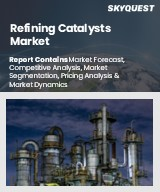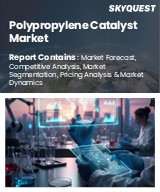
|
시장보고서
상품코드
1796462
정제 촉매 시장 규모, 점유율, 성장 분석 : 유형별, 성분별, 원료별, 지역별 - 산업 예측(2025-2032년)Refining Catalysts Market Size, Share, and Growth Analysis, By Type (Fluid Catalytic Cracking Catalyst, Hydro processing Catalyst), By Ingredients (Metal, Zeolites), By Feedstock, By Region - Industry Forecast 2025-2032 |
||||||
세계의 정제 촉매 시장 규모는 2023년에 42억 달러로 평가되며, 2024년 44억 1,000만 달러에서 2032년에는 65억 1,000만 달러로 성장하며, 예측 기간(2025-2032년)의 CAGR은5%로 성장할 전망입니다.
세계 정유용 촉매 시장은 엄격한 환경 규제와 탄소 배출에 대한 우려 증가로 인해 큰 영향을 받고 있습니다. 황, 질소, 미립자 물질 배출 규제 강화에 대응하기 위해 정련업체들은 활성과 선택성을 높인 촉매 연구개발에 대한 투자를 늘리고 있습니다. 공급업체는 내구성과 작동 효율을 향상시키고 원활한 공정과 다운타임 감소를 촉진하는 신소재와 맞춤형 활성 부위를 혁신하고 있습니다. 또한 디지털화와 데이터 분석의 통합을 통해 촉매의 성능 모니터링이 강화되어 운전 비용을 절감하는 예지보전이 가능해졌습니다. 지속가능성 동향은 재생한 원료에 적합한 촉매에 대한 수요를 촉진하는 한편, 정제업체와 기술 기업 간의 협업은 촉매 설계의 신속한 기술 혁신을 촉진하여 정제 작업의 에너지 원단위 및 배출량 감소에 기여합니다.
목차
서론
- 조사의 목적
- 조사 범위
- 정의
조사 방법
- 정보 조달
- 2차와 1차 데이터 방법
- 시장 규모 예측
- 시장의 전제조건과 제한
개요
- 세계 시장 전망
- 공급과 수요 동향 분석
- 부문별 기회 분석
시장 역학과 전망
- 시장 개요
- 시장 규모
- 시장 역학
- 촉진요인과 기회
- 억제요인과 과제
- Porter의 산업 분석
주요 시장 인사이트
- 주요 성공 요인
- 경쟁의 정도
- 주요 투자 기회
- 시장 에코시스템
- 시장의 매력 지수(2024년)
- PESTEL 분석
- 거시경제 지표
- 밸류체인 분석
- 가격 분석
- 사례 연구
정제 촉매 시장 규모 : 유형별 & CAGR(2025-2032년)
- 시장 개요
- 유동 접촉 분해 촉매
- 수소화 처리 촉매
- 개질 촉매
- 기타
정제 촉매 시장 규모 : 성분별 & CAGR(2025-2032년)
- 시장 개요
- 금속
- 제올라이트
- 화합물
- 기타
정제 촉매 시장 규모 : 원료별 & CAGR(2025-2032년)
- 시장 개요
- 원유
- 진공 경유
- 잔류유
- 바이오 유래 원료
정제 촉매 시장 규모 & CAGR(2025-2032년)
- 북미
- 미국
- 캐나다
- 유럽
- 독일
- 스페인
- 프랑스
- 영국
- 이탈리아
- 기타 유럽
- 아시아태평양
- 중국
- 인도
- 일본
- 한국
- 기타 아시아태평양
- 라틴아메리카
- 브라질
- 기타 라틴아메리카
- 중동 및 아프리카
- GCC 국가
- 남아프리카공화국
- 기타 중동 및 아프리카
경쟁 정보
- 상위 5사의 비교
- 주요 기업의 시장 포지셔닝(2024년)
- 주요 시장 기업이 채택한 전략
- 최근 시장 동향
- 기업의 시장 점유율 분석(2024년)
- 주요 기업의 기업 개요
- 기업의 상세
- 제품 포트폴리오 분석
- 기업의 부문별 점유율 분석
- 매출의 전년대비 비교(2022-2024년)
주요 기업 개요
- W. R. Grace & Co.(United States)
- Albemarle Corporation(United States)
- BASF SE(Germany)
- Clariant AG(Switzerland)
- Honeywell UOP(United States)
- Haldor Topsoe A/S(Denmark)
- Johnson Matthey Plc(United Kingdom)
- Axens SA(France)
- Shell Catalysts & Technologies(Netherlands)
- Evonik Industries AG(Germany)
- Criterion Catalysts & Technologies L.P.(United States)
- Arkema Group(France)
- Zeolyst International(United States)
- Chevron Lummus Global(United States)
- CRI Catalyst Company(United States)
결론과 제안
KSA 25.09.01Global Refining Catalysts Market Size was valued at USD 4.2 Billion in 2023 poised to grow from USD 4.41 Billion in 2024 to USD 6.51 Billion by 2032, growing at a CAGR of 5% in the forecast period (2025-2032).
The global refining catalysts market is significantly influenced by stringent environmental regulations and heightened concerns regarding carbon emissions. To comply with stricter limits on sulfur, nitrogen, and particulate emissions, refiners are increasingly investing in research and development for catalysts that offer enhanced activity and selectivity. Suppliers are innovating new materials and customized active sites that improve durability and operational efficiency, facilitating smoother processes and reduced downtime. Additionally, the integration of digitalization and data analytics is enhancing catalyst performance monitoring, allowing for predictive maintenance that reduces operational costs. Sustainability trends are driving demand for catalysts suitable for renewable feedstocks, while collaboration between refiners and technology firms fosters rapid innovation in catalyst design, contributing to lower energy intensity and emissions in refining operations.
Top-down and bottom-up approaches were used to estimate and validate the size of the Global Refining Catalysts market and to estimate the size of various other dependent submarkets. The research methodology used to estimate the market size includes the following details: The key players in the market were identified through secondary research, and their market shares in the respective regions were determined through primary and secondary research. This entire procedure includes the study of the annual and financial reports of the top market players and extensive interviews for key insights from industry leaders such as CEOs, VPs, directors, and marketing executives. All percentage shares split, and breakdowns were determined using secondary sources and verified through Primary sources. All possible parameters that affect the markets covered in this research study have been accounted for, viewed in extensive detail, verified through primary research, and analyzed to get the final quantitative and qualitative data.
Global Refining Catalysts Market Segments Analysis
The global refining catalysts market is segmented based on type, ingredient, feedstock, and region. In terms of type, the market is divided into fluid catalytic cracking catalyst, hydroprocessing catalyst, reforming catalyst, and others. Based on ingredients, the market is grouped into metal, zeolites, chemical compounds, and others. Based on feedstock, the market is divided into crude oil, vacuum gas oil, residual oil, and bio-derived feedstock. Based on region, the market is segmented into North America, Europe, Asia-Pacific, Central & South America and the Middle East & Africa.
Driver of the Global Refining Catalysts Market
One key market driver for the Global Refining Catalysts Market is the increasing demand for cleaner and more efficient fuels. As environmental regulations tighten and consumer preferences shift towards sustainable energy solutions, refineries are under pressure to produce ultra-low sulfur fuels and minimize emissions. This has resulted in a significant uptick in the adoption of advanced refining catalysts, which enhance the efficiency of hydrocracking, hydrotreating, and catalytic reforming processes. Furthermore, the ongoing transition to cleaner energy sources, alongside the growing emphasis on reducing carbon footprints, further accelerates the need for innovative catalyst technologies that meet both economic and regulatory challenges in the refining sector.
Restraints in the Global Refining Catalysts Market
One of the key market restraints for the global refining catalysts market is the stringent environmental regulations imposed by various governments aimed at reducing greenhouse gas emissions and promoting cleaner technologies. As refineries prioritize compliance with these regulations, many are reluctant to invest in new catalysts that may not meet the required environmental standards or may require additional upgrades to existing processes. Furthermore, the high costs associated with developing and implementing advanced catalyst technologies can deter smaller refiners from participating in the market, thus limiting overall growth and innovation in the refining catalysts sector.
Market Trends of the Global Refining Catalysts Market
The Global Refining Catalysts market is witnessing a significant shift towards the integration of bio-feedstock compatible catalysts, driven by the increasing demand for sustainable refining processes. Refiners are actively seeking catalysts that can accommodate bio-derived feedstocks, including vegetable oils, animal fats, and waste oils, necessitating enhancements in fouling resistance and stability in the presence of various contaminants. As the push for low-carbon fuels intensifies, catalyst suppliers are prioritizing the development of co-processing solutions that enable the simultaneous use of renewable and conventional feedstocks without compromising product quality or operational efficiency. This trend underscores a pivotal transformation in refining operations towards greener and more adaptable technologies.
Table of Contents
Introduction
- Objectives of the Study
- Scope of the Report
- Definitions
Research Methodology
- Information Procurement
- Secondary & Primary Data Methods
- Market Size Estimation
- Market Assumptions & Limitations
Executive Summary
- Global Market Outlook
- Supply & Demand Trend Analysis
- Segmental Opportunity Analysis
Market Dynamics & Outlook
- Market Overview
- Market Size
- Market Dynamics
- Drivers & Opportunities
- Restraints & Challenges
- Porters Analysis
- Competitive rivalry
- Threat of substitute
- Bargaining power of buyers
- Threat of new entrants
- Bargaining power of suppliers
Key Market Insights
- Key Success Factors
- Degree of Competition
- Top Investment Pockets
- Market Ecosystem
- Market Attractiveness Index, 2024
- PESTEL Analysis
- Macro-Economic Indicators
- Value Chain Analysis
- Pricing Analysis
- Case Studies
Global Refining Catalysts Market Size by Type & CAGR (2025-2032)
- Market Overview
- Fluid Catalytic Cracking Catalyst
- Hydroprocessing Catalyst
- Reforming Catalyst
- Others
Global Refining Catalysts Market Size by Ingredients & CAGR (2025-2032)
- Market Overview
- Metal
- Zeolites
- Chemical Compounds
- Others
Global Refining Catalysts Market Size by Feedstock & CAGR (2025-2032)
- Market Overview
- Crude Oil
- Vacuum Gas Oil
- Residual Oil
- Bio-Derived Feedstock
Global Refining Catalysts Market Size & CAGR (2025-2032)
- North America (Type, Ingredients, Feedstock)
- US
- Canada
- Europe (Type, Ingredients, Feedstock)
- Germany
- Spain
- France
- UK
- Italy
- Rest of Europe
- Asia Pacific (Type, Ingredients, Feedstock)
- China
- India
- Japan
- South Korea
- Rest of Asia-Pacific
- Latin America (Type, Ingredients, Feedstock)
- Brazil
- Rest of Latin America
- Middle East & Africa (Type, Ingredients, Feedstock)
- GCC Countries
- South Africa
- Rest of Middle East & Africa
Competitive Intelligence
- Top 5 Player Comparison
- Market Positioning of Key Players, 2024
- Strategies Adopted by Key Market Players
- Recent Developments in the Market
- Company Market Share Analysis, 2024
- Company Profiles of All Key Players
- Company Details
- Product Portfolio Analysis
- Company's Segmental Share Analysis
- Revenue Y-O-Y Comparison (2022-2024)
Key Company Profiles
- W. R. Grace & Co. (United States)
- Company Overview
- Business Segment Overview
- Financial Updates
- Key Developments
- Albemarle Corporation (United States)
- Company Overview
- Business Segment Overview
- Financial Updates
- Key Developments
- BASF SE (Germany)
- Company Overview
- Business Segment Overview
- Financial Updates
- Key Developments
- Clariant AG (Switzerland)
- Company Overview
- Business Segment Overview
- Financial Updates
- Key Developments
- Honeywell UOP (United States)
- Company Overview
- Business Segment Overview
- Financial Updates
- Key Developments
- Haldor Topsoe A/S (Denmark)
- Company Overview
- Business Segment Overview
- Financial Updates
- Key Developments
- Johnson Matthey Plc (United Kingdom)
- Company Overview
- Business Segment Overview
- Financial Updates
- Key Developments
- Axens SA (France)
- Company Overview
- Business Segment Overview
- Financial Updates
- Key Developments
- Shell Catalysts & Technologies (Netherlands)
- Company Overview
- Business Segment Overview
- Financial Updates
- Key Developments
- Evonik Industries AG (Germany)
- Company Overview
- Business Segment Overview
- Financial Updates
- Key Developments
- Criterion Catalysts & Technologies L.P. (United States)
- Company Overview
- Business Segment Overview
- Financial Updates
- Key Developments
- Arkema Group (France)
- Company Overview
- Business Segment Overview
- Financial Updates
- Key Developments
- Zeolyst International (United States)
- Company Overview
- Business Segment Overview
- Financial Updates
- Key Developments
- Chevron Lummus Global (United States)
- Company Overview
- Business Segment Overview
- Financial Updates
- Key Developments
- CRI Catalyst Company (United States)
- Company Overview
- Business Segment Overview
- Financial Updates
- Key Developments



















